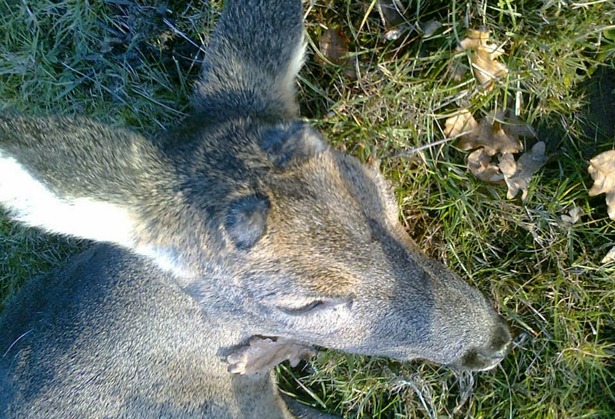The 'Antlered Doe'.... sounds a little like the 'Bearded Lady', unbelievable until you actually see one. But seen one I have. No not the bearded lady of course but the antlered Doe. In fact not just one but one or two more or less every year.

("Many will appear as no more than simple pedicle growth" Thanks to Tony Ridddell for this photo. A mature Roe Doe culled by Tony with County Deer Stalking winter 2012).
If you stalk deer for long enough you are bound to come across one of these contradictions in nature which are in fact not as uncommon as one might expect and this is particular true in Roe Does.
So what is the cause of this anomaly? Well the cause is fairly straight forward and has to do I am afraid with these old dames hormones going up the spout.
Consistently antlered Does or antlered Hinds will almost invariably be old animals and as with other species including our own as we age hormones can play havoc with outward appearances, a fact to which some bearded aunts are testament!
The antler growth of such a Doe will usually be irregular and no more than a few inches in length, it will remain in velvet and each antler will usually be of differing sizes, many will appear as no more than simple pedicle growth similar to that of a button buck.
Despite this imbalance of hormones the ability to breed is not usually inhibited and I have found most of these old animals to be pregnant. It also does not have any impact on the animals well being and a dispatched animal will remain fit for the food chain albeit it will make for some tough eating!
The problem comes with identification. One of the main indicators of the sex of a deer is the presence of antlers. However during the Doe season itself the overriding indicator should in fact be the presence of an 'anal tush'.
I know I keep harping on about 'tush' as though I'm obsessed with it and I may be but that's a different matter, however it remains the sure fire way of determining a Doe from a Buck and verification of its presence should whenever possible be sought. The issue is however more or less mute during the Doe season as the presence of antlers will usually mean that the Doe is sparred.
The problem comes more sharply into focus during the early part of the Buck season when our antlered Doe will have young dependent kids and the presence of her small antlers in velvet will appear to the would be deer stalker to be the sign of a young cull buck. Added to this the difficulty is multiplied by the fact that in summer coat her 'anal tush' will be considerably less visible.
This is recipe for disaster and I am afraid will inevitably lead to the occasional mistake. If you cull an antlered Doe out of season under the assumption that it is a buck every effort should be made to trace her young and dispatch them to save them the drawn out inevitability of starvation.
The best advice I can give is to urge a little common sense in order to try and avoid these mishaps. If you are glassing a deer with small malformed antlers in full velvet assess its body condition. Small antlers in a buck will usually mean a yearling, yet if you have a heavy, mature animal in your sights then apply some logic and consider the possibility that the animal is in fact one of these anomaly's of nature and spare the Old Dear and her young!


















